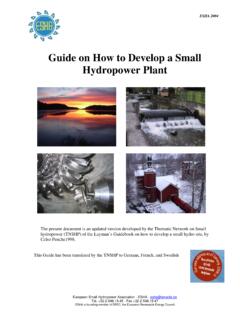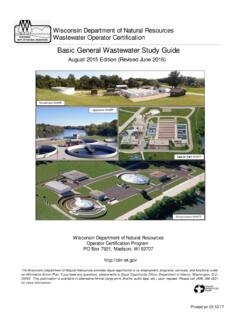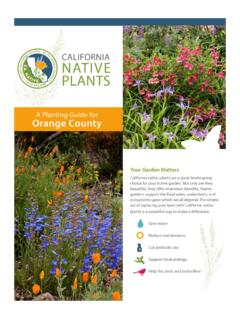Transcription of Guide on How to Develop a Small Hydropower Plant
1 ESHA 2004. Guide on How to Develop a Small Hydropower Plant The present document is an updated version developed by the Thematic Network on Small Hydropower (TNSHP) of the Layman's Guidebook on how to Develop a Small hydro site, by Celso Penche1998. This Guide has been translated by the TNSHP to German, French, and Swedish European Small Hydropower Association - ESHA - Tel. + - Fax + ESHA is founding member of EREC, the European Renewable Energy Council ESHA 2004. INDEX. Acknowledgements i Executive Summary ii Chapter 1. Introduction 1. Chapter 2. Fundamental of Hydraulic Engineering 12. Chapter 3. Evaluating Stream Flow 42. Chapter 4. Site Evaluation Methodologies 71. Chapter 5. Hydraulic Structures 91. Chapter 6.
2 Electromechanical Equipment 152. Chapter 7. Environmental impact and its mitigation 199. Chapter 8. Economic analysis 236. Chapter 9. Administrative procedures 254. Glossary 290. European Small Hydropower Association - ESHA - Tel. + - Fax + ESHA is founding member of EREC, the European Renewable Energy Council Guide on How to Develop a Small Hydropower Plant ESHA 2004. ACKNOWLEDGEMENTS. This Guide is an updated and adapted version of the publication Layman's Guidebook on How to Develop a Small Hydro Site , published by ESHA - the European Small Hydropower Association . in 1998 in the frame of the European Commission DG-TREN (Directorate General for Transport and Energy) ALTENER programme. Although based on the original, this Guide has been entirely updated and adapted due to significant changes in the sector in the latest years as concern environmental and administrative aspects in particular.
3 The updated version is available in English, French, German and Swedish what has added value to the already existing Spanish and Italian versions of the original publication. The Guide on how to Develop a Small Hydro Site has been carried out within the EC Project Thematic Network on Small Hydropower , financed by the Fifth RD&D Framework Programme (FP5). It has been updated and adapted by a Revision Committee under the coordination and guidelines of ESHA. Members of the Revision Committee include the project partners Francis Armand (ADEME), Anton Schleiss (EPFL-LCH), Erik Bollaert (EPFL-LCH), Pedro Manso (EPFL-LCH), Jochen Bard (ISET), Jamie O'Nians (IT Power), Vincent Denis (MHyLab), Bernhard Pelikan ( VFK), Jean-Pierre Corbet (SCPTH), Christer S derberg (SERO), Jonas Rundqvist (SERO) and Luigi Papetti (Studio Frosio).
4 The network thanks Steve Cryer (BHA) for his input. Special thanks to Celso Penche (ESHA), author of the Layman's Guide , who has revised the contents of the current Guide guaranteeing its consistency and accuracy. ESHA 2004. i Guide on How to Develop a Small Hydropower Plant ESHA 2004. EXECUTIVE SUMMARY. Developing a Small Hydropower site is not a simple task. There are many aspects which have to be taken into consideration, covering many disciplines ranging from business, engineering, financial, legal and administration. These will all be necessary at the different development stages from, first choosing a site until the Plant goes into operation. The Laymans Guide Guide brings together all of these aspects in a step-by-step approach, and will serve as a useful tool for a potential developer of a Small Hydropower scheme.
5 This Guide is divided into nine chapters and covers the basic concepts, meaning of definitions and technological issues to be addressed. Chapter 1 Introduces basic concepts, such as the definition of Small Hydropower , types of schemes, ways of exploiting the water resource available and gives a general overview of the Guide 's contents, Chapters 2 through to 9 describe the essential steps to be followed to evaluate a proposed scheme before deciding whether to proceed to a detailed feasibility study. The basic concepts considered in the Guide are: Topography and geomorphology of the site. Evaluation of the water resource and its generating potential. Site selection and basic layout. Hydraulic turbines and generators and their control.
6 Environmental impact assessment and mitigation measures. Economic evaluation of the project and financing potential. Institutional framework and administrative procedures to obtain the necessary consents Reading this Guide will inform the potential Small Hydropower developer and give a better understanding of the different issues, phases and procedures that need be followed to Develop and run a Small Hydropower operation. Bernhard Pelikan President ESHA. ii Guide on How to Develop a Small Hydropower Plant ESHA 2004. CHAPTER 1: INTRODUCTION. CONTENTS. 1 INTRODUCTION .. 2. A free fuel resource potentially everlasting.. 2. Definition of Small 3. Site configurations .. 3. Run-of-river 3. Schemes with the powerhouse at the base of a dam.
7 5. Schemes integrated within an irrigation canal .. 7. Schemes integrated in a water abstraction 8. Planning a Small Hydropower 8. LIST OF FIGURES. Figure 1-1 High head scheme .. 4. Figure 1-2 Low head scheme with 4. Figure 1-3 Low head scheme integrated in the dam .. 5. Figure 1-4 Low head scheme using an existing 6. Figure 1-5 Low head scheme siphon intake .. 6. Figure 1-6 Integrated scheme using an irrigation 7. Figure 1-7 Elongated spillway scheme using an irrigation canal .. 7. Figure 1-8 Scheme integrated in a water supply 8. 1. Guide on How to Develop a Small Hydropower Plant ESHA 2004. 1 INTRODUCTION i A free fuel resource potentially everlasting. Following the Third Conference of the Parties to the United Nations Framework Convention on Climate Change held in Kyoto in December 1997, the European Union has recognized the urgent need to tackle the climate change issue.
8 It has also adopted a target to reduce greenhouse gas emissions by 8 % by 2010 from 1990 levels, whereas for other industrialised countries the target is 5 %. To facilitate the Member States achieving this objective, the Commission identified a series of actions, focusing on reducing energy consumption and carbon emissions (CO2). The development of energy from renewable resources is a very important step in the reduction of CO2 emissions. Therefore the EU Council and Parliament has brought forward Directive 2001/77/EC for the promotion of electricity produced from renewable energy resources Electricity production from Hydropower has been, and still is today, the first renewable source used to generate electricity.
9 Nowadays Hydropower electricity in the European Union - both large and Small scale represents, according to the White Paper, 13% of the total electricity generated, so reducing the CO2 emissions by more than 67 million tons a year. But whereas the conventional hydro requires the flooding of large areas of land, with its consequential environmental and social issues, the properly designed Small hydro schemes are easily integrated into local ecosystems. In 2001, approximately 365 TWh of hydro energy was produced in the European Union from an overall capacity of 118 GW. Small hydro plants accounted for of installed capacity ( GW). and produced 39 TWh (about 11% of Hydropower generation). Given a more favorable regulatory environment, the European Commission objective of 14000 MW by 2010 should be achievable and that Small hydro would be the second largest contributor behind windpower.
10 The large majority of Small hydro plants are run-of-river schemes, meaning that they have no or relatively Small water storage capability. The turbine only produces power when the water is available and provided by the river. When the river flow falls below some predetermined value, the generation ceases. Some plants are stand alone systems used in isolated sites, but in most cases in Europe, the electricity generated is connected to the grid. Stand-alone, Small , independent schemes may not always be able to supply energy, unless their size is such that they can operate whatever the flow in the river is. In some cases, this problem can be overcome by using any existing lakes or reservoir storage that exists upstream, of the Plant .











